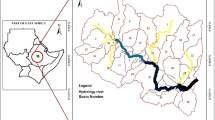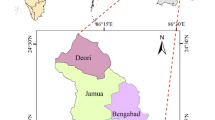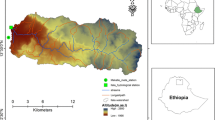Abstract
This study focuses on analysis of future climate change impacts on West Nishnabotna Watershed, using climate model data and an open source hydrological model—Soil and Water Assessment Tool (SWAT), which is run in Quantum Geographical Information System(QGIS) environment. The data required to simulate hydrological processes using SWAT plugin in QGIS (QSWAT) are Digital Elevation Model, land use/landcover map, soil map, slope map and climate data of the study area. The required climate parameters like maximum temperature, minimum temperature and precipitation are obtained from North American Regional Climate Change Assessment Program climate model database which are bias corrected for the study area using linear scaling method. SWAT model is setup using observed climate and the model calibration and validation is performed using SWAT Calibration and Uncertainty Program (SWAT-CUP). Simulations are run for historic (1971–1999) and future (2041–2069) climate conditions for the stream flow prediction. The climate change impact analysis like anomalies and trends in the hydrological regime of the watershed are carried out based on QSWAT simulation results.






Similar content being viewed by others
References
Chien, H., Yeh, P. J. F., & Knouft, J. H. (2013). Modeling the potential impacts of climate change on streamflow in agricultural watersheds of the Midwestern United States. Journal of Hydrology, 491, 73–88.
Erturk, A. (2012). Managing the effects of the climate change on water resources and watershed ecology. In M. V. Kumarasamy (Ed.), Studies on Water Management Issues. London: InTech.
Arnold, J. G., Srinivasan, R., Muttiah, R. S., & Williams, J. R. (1998). Large area hydrologic modeling and assessment part I: Model development. Journal of the American Water Resources Association, 34(1), 73–89.
Bicknell, B. R., Imhoff, J. C., Kittle, J. L., Jr., Jobes, T. H., Donigian, A. S., Jr., & Johanson, R. (2001). Hydrological simulation program–fortran: HSPF, version 12 user’s manual. Mountain View, California: AQUA TERRA Consultants.
Downer, C. W., & Ogden, F. L. (2004). GSSHA: Model to simulate diverse stream flow producing processes. Journal of Hydrologic Engineering, 9(3), 161–174.
Gassman, P. W., Reyes, M. R., Green, C. H., & Arnold, J. G. (2007). The soil and water assessment tool: Historical development, applications, and future research directions. Transactions of the American Society of Agricultural and Biological Engineers, 50(4), 1211–1250.
Arnold, J. G., Moriasi, D. N., Gassman, P. W., Abbaspour, K. C., White, M. J., Srinivasan, R., et al. (2012). SWAT: model use, calibration, and validation. American Society of Agricultural and Biological Engineers, 55(4), 1491–1508. ISSN 2151-0032.
Dile, Y. T., Daggupati, P., George, C., Srinivasan, R., & Arnold, J. (2016). Introducing a new open source GIS user interface for the SWAT model. Environmental Modelling and Software, 85, 129–138.
Beven, K., & Binley, A. (1992). The future of distributed models: Model calibration and uncertainty prediction. Hydrological Processes, 6(3), 279–298.
Kuczera, G., & Parent, E. (1998). Monte Carlo assessment of parameter uncertainty in conceptual catchment models: The Metropolis algorithm. Journal of Hydrology, 211(1), 69–85.
van Griensven, A., & Meixner, T. (2006). Methods to quantify and identify the sources of uncertainty for river basin water quality models. Water Science and Technology, 53(1), 51–59.
Abbaspour, K. C. (2007). User manual for SWAT-CUP, SWAT calibration and uncertainty analysis programs. Duebendorf, Switzerland: Swiss Federal Institute of Aquatic Science and Technology, Eawag.
Daggupati, P., Deb, D., Srinivasan, R., Yeganantham, D., Mehta, V. M., & Rosenberg, N. J. (2016). Large-scale fine-resolution hydrological modeling using parameter regionalization in the Missouri River Basin. Journal of the American Water Resources Association, 52(3), 648–666.
Mehta, V. M., Rosenberg, N. J., & Mendoza, K. (2011). Simulated impacts of three decadal climate variability phenomena on water yields in the Missouri River Basin. Journal of the American Water Resources Association, 47(1), 126–135.
Mearns, L. O., Gutowski, W., Jones, R., Leung, R., McGinnis, S., Nunes, A., et al. (2009). A regional climate change assessment program for North America. Eos, Transactions American Geophysical Union, 90(36), 311.
Lenderink, G., Buishand, A., & Deursen, W. V. (2007). Estimates of future discharges of the river Rhine using two scenario methodologies: Direct versus delta approach. Hydrology and Earth System Sciences, 11(3), 1145–1159.
Ines, A. V. M., & Hansen, J. W. (2006). Bias correction of daily GCM rainfall for crop simulation studies. Agricultural and Forest Meteorology, 138(1–4), 44–53.
Teutschbein, C., & Seibert, J. (2010). Regional climate models for hydrological impact studies at the catchment scale: A review of recent modeling strategies: Regional climate models for hydrological impact studies. Geography Compass, 7, 834–860.
Moriasi, D. N., Arnold, J. G., Van Liew, M. W., Binger, R. L., Harmel, R. D., & Veith, T. L. (2007). Model evaluation guidelines for systematic quantification of accuracy in watershed simulations. Transactions of the American Society of Agricultural and Biological Engineers, 50(3), 885–900.
Acknowledgements
Part of the work presented in this paper is carried out at Texas A&M University, College Station by the Second Author (Venkata Reddy K) as part of the Raman fellowship provided by the Government of India. We wish to thank Dr. Seth McGinnis and other scientists of North American Regional Climate Change Assessment Program (NARCCAP) for providing the data used in this paper.
Author information
Authors and Affiliations
Corresponding author
Electronic supplementary material
Below is the link to the electronic supplementary material.
Rights and permissions
About this article
Cite this article
Reddy, N.N., Reddy, K.V., Vani, J.S.L.S. et al. Climate change impact analysis on watershed using QSWAT. Spat. Inf. Res. 26, 253–259 (2018). https://doi.org/10.1007/s41324-017-0159-6
Received:
Revised:
Accepted:
Published:
Issue Date:
DOI: https://doi.org/10.1007/s41324-017-0159-6




